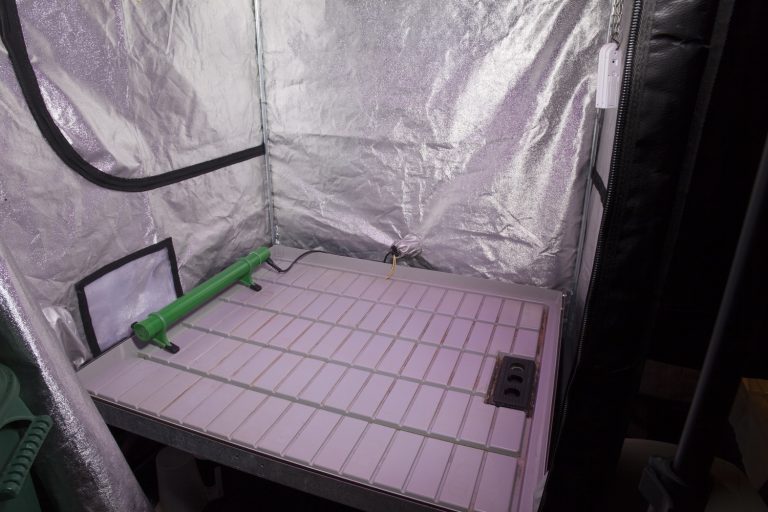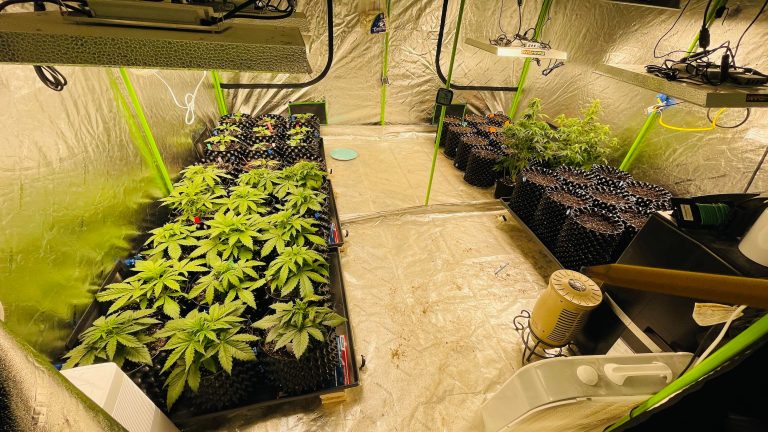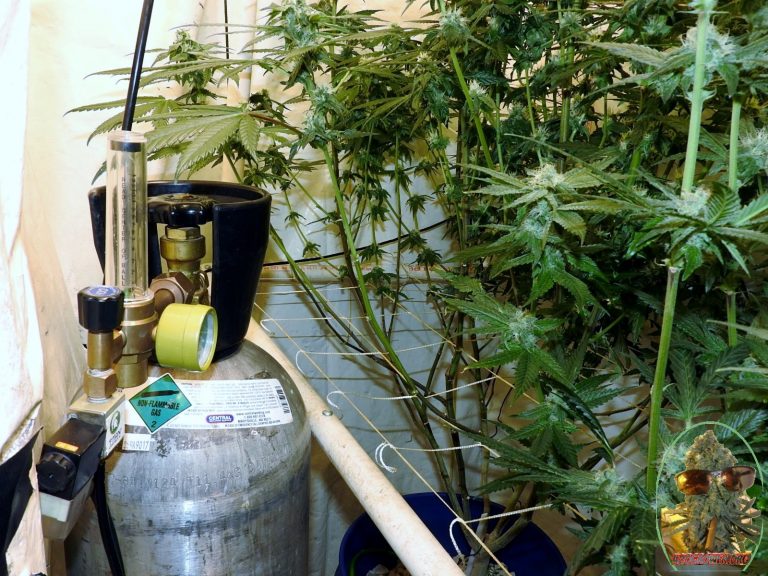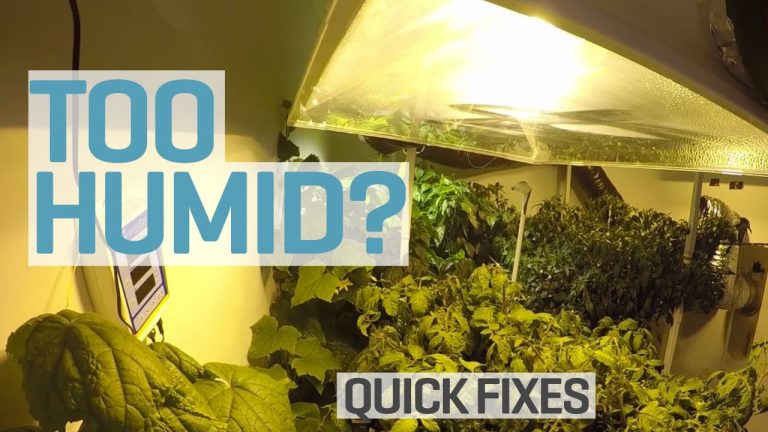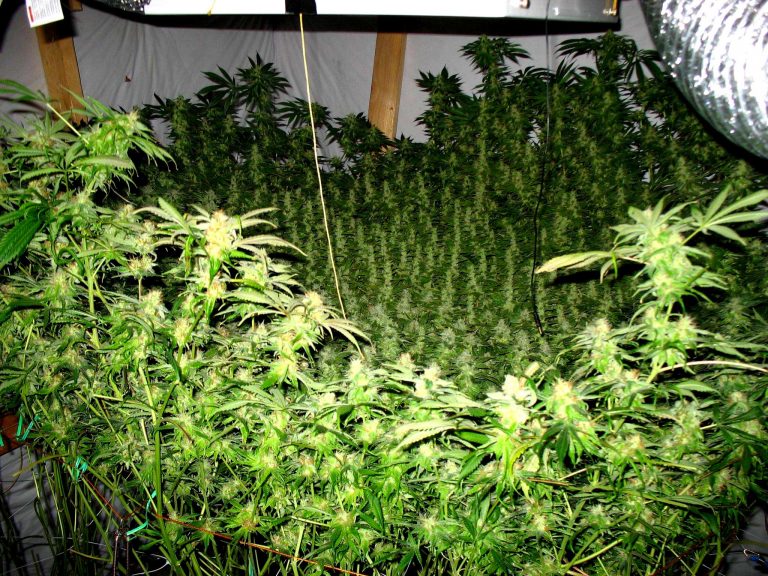How to Prevent Powdery Mildew in Grow Tent
Powdery mildew is a common problem for indoor gardeners, especially those growing in grow tents. The good news is that there are several things you can do to prevent powdery mildew from taking over your plants.
First, make sure you have proper ventilation in your grow tent.
Powdery mildew thrives in humid environments, so good air circulation is key to preventing it. If possible, open the doors or windows of your grow tent for a few hours each day to let fresh air in and help keep humidity levels down.
Second, water your plants early in the day so they have time to dry off before nightfall.
Wet leaves overnight provide the perfect environment for powdery mildew to take hold.
Finally, consider using an organic fungicide such as neem oil or sulfur to help prevent powdery mildew from getting a foothold in your grow tent. These products are safe to use around people and pets and can be applied directly to affected plants as needed.
- Start with a clean grow tent – remove all plants, debris, and old leaves
- If possible, disinfect the tent with a bleach solution
- Make sure your plants have plenty of airflow around them
- Powdery mildew thrives in humid, moist environments
- Water your plants early in the day so they have time to dry off before nightfall
- Consider using a fan to circulate air around the grow tent and help prevent powdery mildew from taking hold
- Monitor your plants closely for signs of powdery mildew and address any issues immediately
4 Tips on How To Prevent Powdery Mildew In Grow Rooms
How to Clean Grow Tent After Powdery Mildew
If you’re a grower, chances are you’ve had to deal with powdery mildew at some point. Powdery mildew is a type of fungi that can attack your plants and cause them to become covered in a white, powdery substance. While it’s not necessarily harmful to your plants, it can reduce their yield and quality.
So how do you get rid of powdery mildew? The first step is to clean your grow tent. Remove all of the plants and any debris from the floor of the tent.
Then, using a sponge or brush, scrub all of the surfaces of the tent – walls, ceilings, floors – with soapy water. Rinse the soap off with clean water and allow the tent to dry completely before setting up again.
Once your grow tent is clean, there are a few things you can do to prevent powdery mildew from returning.
First, make sure that your plants have plenty of airflow around them. Second, Avoid overwatering – too much moisture is one of the main things that leads to powdery mildew growth.
How to Get Rid of Powdery Mildew During Flower
If you’re dealing with powdery mildew on your flowers, don’t worry – it’s a common problem that can be easily remedied. Here are a few tips on how to get rid of powdery mildew:
1. Start by removing any affected leaves or flowers.
This will help to prevent the spread of the disease.
2. Make sure to water your plants early in the day so that the leaves have time to dry before nightfall. Wet leaves are more susceptible to powdery mildew.
3. Use a fungicide specifically designed for powdery mildew (you can find these at most garden stores). Be sure to follow the directions carefully and apply as needed according to the package instructions.
4. Take preventive measures next year by planting resistant varieties of flowers or by using a sulfur-based fungicide at the beginning of the season.
Powdery Mildew in Flowering Buds
Powdery mildew is one of the most common fungal diseases that can affect flowering buds. The disease is caused by a fungus called Podosphaera tridactyla which lives on the surface of the plant. The fungus grows best in warm, humid conditions and can spread quickly if not treated early.
Symptoms of powdery mildew include white or greyish powdery spots on the leaves, stems, and flowers. The spots are usually more prominent on the upper side of the leaf. As the disease progresses, the leaves may turn yellow or brown and curl up at the edges.
Severely affected leaves may drop off prematurely.
If you suspect your plant has powdery mildew, it’s important to act quickly as the disease can spread rapidly to other parts of the plant and nearby plants. You can treat powdery mildew with a number of fungicides available from garden stores or online retailers.
Be sure to follow directions carefully and apply fungicide early in the morning or evening when temperatures are cooler to avoid harming bees and other pollinators that are active during daylight hours.
Hydrogen Peroxide for Powdery Mildew During Flowering
As soon as you see powdery mildew on your flowers, it’s time to take action. Powdery mildew is a fungal disease that can spread quickly and ruin your entire crop. The good news is that hydrogen peroxide can help get rid of powdery mildew quickly and effectively.
Here’s what you need to do:
1. Combine 1 cup of hydrogen peroxide with 1 cup of water in a spray bottle.
2. Shake the mixture well and then spray it onto the affected flowers.
3. Repeat this process once per day until the powdery mildew is gone.
Hydrogen peroxide is a great way to get rid of powdery mildew because it’s safe for humans and animals, it’s inexpensive, and it works quickly. So if you see powdery mildew on your flowers, don’t hesitate to give hydrogen peroxide a try!
Powdery Mildew Late Flower Vinegar
Since ancient times, vinegar has been used as a natural remedy for powdery mildew. The high acidity of vinegar makes it an inhospitable environment for powdery mildew spores. To make a late flower vinegar, mix one part apple cider vinegar with two parts water in a spray bottle and shake well.
Apply the mixture to affected plants, being sure to coat all surfaces evenly. This treatment can be repeated every seven to ten days as needed.
Powdery Mildew Inhalation
Most people are familiar with powdery mildew on plants, but did you know that it can also be inhaled? Powdery mildew is a type of fungi that grows in warm, humid conditions and produces a fine powdery substance. When the spores are released into the air, they can be breathed in and cause respiratory problems.
Symptoms of powdery mildew inhalation include coughing, difficulty breathing, and wheezing. The spores can irritate the lungs and cause inflammation. In severe cases, it can lead to pneumonia or bronchitis.
If you have any of these symptoms, it’s important to see a doctor right away.
There are several things you can do to prevent powdery mildew growth in your home. Keep the humidity levels low by using a dehumidifier or opening windows when possible.
You should also clean any areas where mold is present with bleach or another disinfectant. If you have plants inside your home, make sure to water them early in the day so that the leaves have time to dry before nightfall. By taking these precautions, you can help keep your family safe from powdery mildew inhalation.
Powdery Mildew Autoflower
Powdery mildew is a type of fungus that can affect autoflowering cannabis plants. The fungus produces a white, powdery substance on the leaves and stems of the plant, which can eventually lead to leaf death. Powdery mildew is most commonly found in humid or damp environments, and can spread quickly if not treated.
If you suspect that your autoflowering cannabis plant has powdery mildew, it’s important to take action immediately. The first step is to remove any affected leaves from the plant. You can then treat the plant with a fungicide designed for powdery mildew (you can find these at most garden stores).
Be sure to follow the directions on the fungicide label carefully.
In some cases, powdery mildew can be difficult to get rid of completely. If you find that your plant continues to be affected by the fungus, you may need to start over with a new seed or clone.
Powdery Mildew Week 8 of Flower
Powdery mildew is a fungal disease that affects a wide range of plants. It is characterized by white, powdery spores on the leaves and stems of the plant. Powdery mildew can weaken and even kill plants if left unchecked.
This week, we’re focusing on powdery mildew in flower crops. This disease is particularly troublesome for growers because it can reduce the quality and yield of their flowers. In some cases, powdery mildew can even cause the flowers to rot.
There are several things that you can do to prevent powdery mildew in your flower crops:
1) Plant resistant varieties whenever possible. Some varieties of flowers are more resistant to powdery mildew than others.
Check with your local extension office or seed supplier for recommendations on powdery mildew-resistant varieties.
2) Keep your flowers healthy and stress-free. Healthy plants are better able to resist fungal diseases like powdery mildew.
Make sure to provide your flowers with adequate water, nutrients, and light. Avoid over- or under-watering them, as both can lead to stressed plants that are more susceptible to diseases.
3) Practice good sanitation in your greenhouse or growing area.
Remove any affected leaves or plant parts from the area immediately as they can spread the disease to other plants quickly if left unchecked.
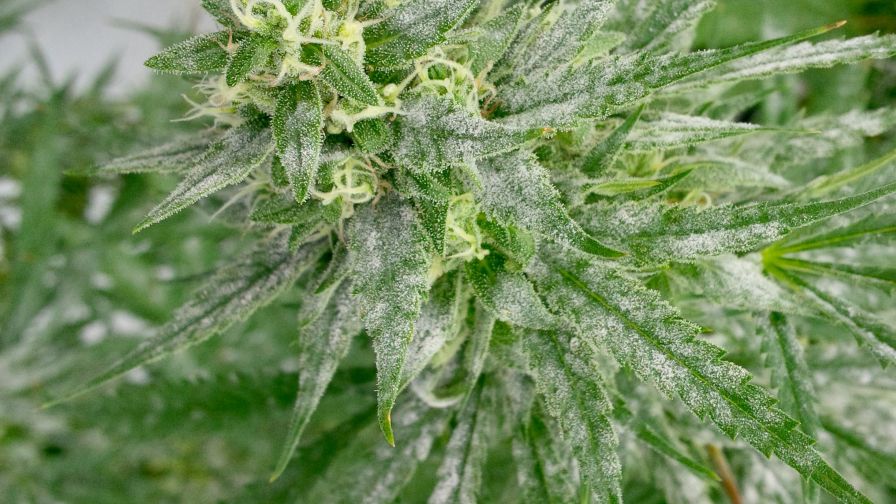
Credit: www.greenhousegrower.com
Why Do I Keep Getting Powdery Mildew in My Grow Tent?
If you’re a cannabis grower, chances are you’ve had to deal with powdery mildew at some point. Powdery mildew is a type of fungus that can infect your plants and cause them to produce small, white, powdery spores. While this isn’t a serious problem for most plants, it can be devastating for cannabis crops.
There are a few reasons why you might be dealing with powdery mildew in your grow tent. The first reason is humidity. Powdery mildew thrives in humid environments, so if your grow tent is too humid, it’s more likely to develop this problem.
Make sure you’re using a dehumidifier in your grow tent and keeping the humidity level below 60%.
Another reason you might be getting powdery mildew is because of poor air circulation. If the air in your grow tent isn’t circulating properly, it can create pockets of stagnant air where mold and fungi can thrive.
Make sure your grow tent has plenty of ventilation so that air can circulate freely.
Finally, another common cause of powdery mildew is watering your plants too often or with water that’s too cold. When water droplets sit on leaves for extended periods of time, they create an ideal environment for mold and fungus to grow.
So make sure you’re not over-watering your plants and that the water you’re using is room temperature or warmer.
Powdery mildew can be a frustrating problem for cannabis growers but fortunately there are things you can do to prevent it from happening in the first place. By controlling the humidity levels in your grow tent and ensuring good air circulation, you should be able to keep this problem at bay.
How Do I Get Rid of White Powdery Mildew in My Grow Tent?
If you notice white powdery mildew in your grow tent, don’t panic! This common fungus is easy to get rid of with the right tools and techniques.
First, identify the source of the problem.
Powdery mildew usually starts on leaves that are already damaged or stressed. These conditions make it easier for the fungus to take hold. Once powdery mildew has started, it can spread quickly to healthy leaves and other parts of the plant.
To get rid of powdery mildew, start by removing all infected leaves. Throw them away in a sealed bag so they don’t spread the fungus to other plants. Then, increase air circulation around your plants by opening up vents or windows in your grow tent.
The extra airflow will help dry out wet leaves, which makes it harder for powdery mildew to survive.
Next, clean all surfaces in your grow tent with a solution of 1 part bleach to 10 parts water. This will kill any remaining spores and prevent them from spreading.
Finally, treat your plants with a fungicide labeled for use against powdery mildew. Be sure to follow the instructions on the label carefully so you don’t damage your plants!
Can Powdery Mildew Be Stopped?
Can powdery mildew be stopped? Yes, it can. There are a few things you can do to prevent and stop powdery mildew from growing on your plants.
These include:
1. Water early in the day so that the leaves have time to dry before nightfall. Powdery mildew thrives in humid conditions.
2. Avoid overhead watering which can promote humid conditions and encourage powdery mildew growth.
3. Prune infected leaves and branches to improve air circulation around the plant which will help reduce humidity levels.
How Do You Stop Pm in Grow Room?
There are a few things you can do to help prevent or stop pm in your grow room. One is to make sure the room is well ventilated. Another is to use an air purifier.
And finally, you can try using a product like PM Stop.
Conclusion
Powdery mildew can be a problem for growers, especially those growing in enclosed spaces like grow tents. The good news is that there are a few things you can do to prevent powdery mildew from becoming a problem in your grow tent.
One of the best ways to prevent powdery mildew is to make sure your grow tent has good ventilation.
Powdery mildew loves humid environments, so making sure your tent has plenty of airflow will help keep it at bay. You should also avoid overcrowding your plants in the tent, as this can create pockets of humid air where powdery mildew can thrive.
If you do find powdery mildew on your plants, it’s important to act quickly.
Isolate any affected plants and remove all dead leaves or infected areas. You can also treat the plants with a fungicide designed specifically for powdery mildew. Following these tips will help you keep powdery mildew out of your grow tent and ensure healthy plants all season long!
